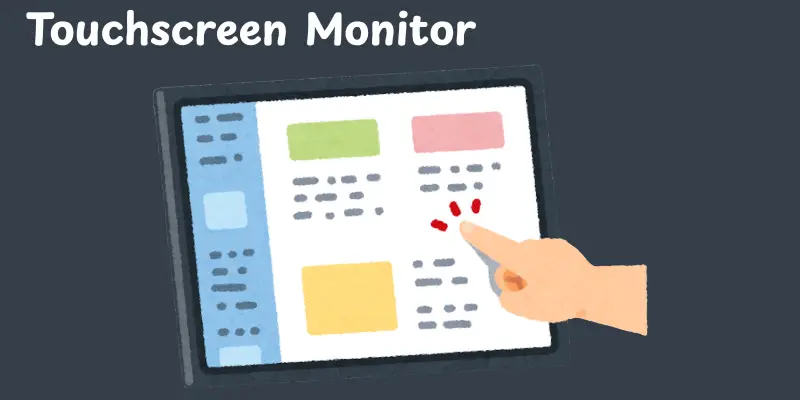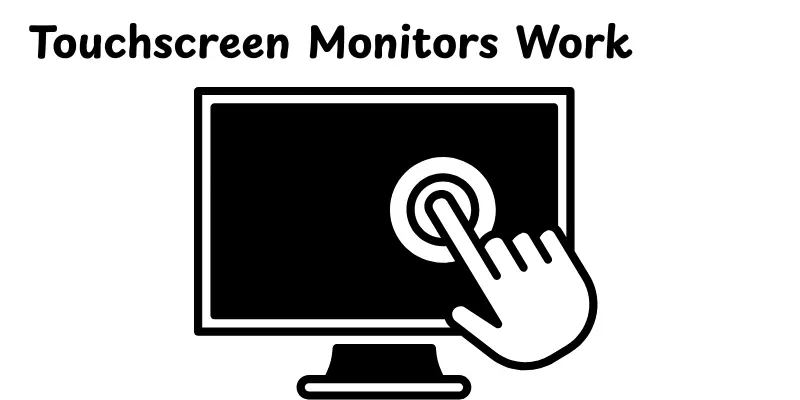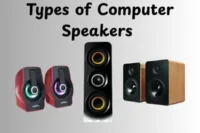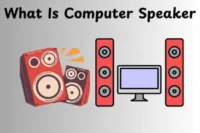What is a Touchscreen Monitor? Features, Uses & Benefits Explained
Published: 10 Oct 2025
Did you know that touchscreen monitors are becoming a standard in offices, retail, and education worldwide? These unique screens allow users to interact directly with their devices using taps, swipes, and gestures. Understanding what a touchscreen monitor is can help you choose the right device for work, learning, or entertainment.You can also explore the different uses of computer monitors to see how they make everyday tasks easier and more interactive.
What Is a Touchscreen Monitor?
A touchscreen monitor is a display device that allows users to interact directly with the screen using their fingers, a stylus, or gestures. Unlike traditional monitors, it eliminates the need for a keyboard or mouse for basic navigation, making tasks faster and more clear.

History Of Touchscreen Monitor
Touchscreen technology has changed over many decades, transforming the way we interact with computers and devices. The idea started in the 1960s and has grown into the responsive, fast, and accurate screens we use today.
- 1965: The first touchscreen prototype was developed by E.A. Johnson in the UK, using a capacitive technology concept for air traffic control.
- 1971: Dr. Sam Hurst invented the first resistive touchscreen at the University of Kentucky.
- 1983: HP introduced a touchscreen computer for commercial use called the HP-150.
- 1990s: Touchscreen devices became more common in kiosks, ATMs, and point-of-sale systems.
- 2000s: Capacitive touchscreens became popular in smartphones and tablets, improving responsiveness and multitouch gestures.
- 2010s: Touchscreen monitors for PCs, gaming, and education became widely available, offering interactive experiences.
- Today: Modern touchscreen monitors are fast, accurate, and used in offices, classrooms, retail, and creative industries.
Why Touchscreen Monitors Are Important
Touchscreen monitors make computers more interactive and easy to use. They help people work faster, learn better, and enjoy smoother control with just a touch.
- Direct Interaction: Users can control the system instantly with taps and gestures.
- Faster Navigation: Swiping and scrolling speeds up tasks compared to traditional input devices.
- Enhanced Engagement: Ideal for learning, gaming, and interactive applications.
- Accessibility: Helps people who struggle with using a keyboard or mouse.
- Versatile Usage: Widely used in offices, classrooms, retail, and public kiosks.
How Does Touchscreen Monitors Work

Touchscreen monitors allow you to touch directly with the screen. Here’s the process:
- Display Layer: Shows visuals like any normal monitor.
- Touch-Sensitive Layer: Detects your finger or stylus contact.
- Controller: Processes the touch input and sends it to the device.
- Input Detection: Uses technologies like resistive, capacitive, or infrared to sense touch or gestures.
- Device Response: The computer executes commands instantly (e.g., opening apps, typing text).
- Direct Interaction: Tap, swipe, or pinch directly on the screen for easy control.
Types of Touchscreen Monitors
Touchscreen monitors come in different technologies, each designed for specific uses and environments. Understanding the types helps you choose the right one for work, gaming, or interactive displays.
- Resistive Touchscreen: Works by pressing the screen with a finger or stylus.
- Capacitive Touchscreen: Detects touch using the electrical properties of your finger.
- Infrared Touchscreen: Uses infrared light beams to detect touch.
- Surface Acoustic Wave (SAW): Uses sound waves on the screen surface to sense touch.
- Optical Imaging Touchscreen: Detects touch using cameras or light sensors around the screen.
- Projected Capacitive Touchscreen: Supports multi-touch and gestures with high sensitivity.
Uses of Touchscreen Monitors
Touchscreen monitors are versatile devices that make interacting with computers and other systems easier and faster. They are widely used in work, education, entertainment, and daily life for more intuitive control and efficiency.
- Retail and POS Systems: Quickly process sales and transactions with touch controls.
- Education and Classrooms: Interactive lessons and learning apps enhance student engagement.
- Healthcare: Doctors and nurses use them for patient records and medical devices.
- Gaming: Provides immersive gameplay with direct touch control.
- Kiosks and ATMs: Users can easily navigate menus and services.
- Graphic Design and Art: Artists can draw or design directly on the screen.
- Industrial Control Panels: Manage machinery and operations efficiently.
- Office Work: Streamlines presentations, spreadsheets, and document handling.
- Hospitality and Restaurants: Order management and customer self-service.
- Public Information Displays: Interactive maps, schedules, and directories for users.
Advantages and Disadvantages of Touchscreen Monitors
Touchscreen monitors offer a modern, interactive way to use computers and devices. They provide convenience, speed, and versatility, but they also come with some limitations.
| Advantages |
|---|
|
| Disadvantages |
|---|
|
Conclusion
So guys, in this article, we have covered Touchscreen Monitors in detail. I personally recommend choosing a touchscreen monitor that fits your daily needs—whether for work, gaming, or creative projects. Explore different models, compare features, and upgrade your setup today for a more interactive and efficient experience.
FAQs
A touchscreen allows users to interact directly with a device by tapping, swiping, or dragging on the screen. It replaces the need for a keyboard or mouse for many tasks. This makes navigation and control faster and more intuitive.
Touchscreen monitors make using a computer more interactive and user-friendly. They allow quick access to apps, tools, and features without extra devices. They are ideal for work, learning, gaming, and creative projects.
The main types include resistive, capacitive, infrared, and surface acoustic wave (SAW) screens. Each type works differently and offers different levels of accuracy and durability. Choosing the right type depends on your usage needs.
Touchscreen monitors make navigation faster and more intuitive. They reduce the need for extra devices like a mouse or keyboard. They are especially helpful for creative work, gaming, and interactive learning.
Yes, they allow you to perform tasks quickly by tapping or swiping. Multitasking becomes easier with direct screen interaction. You can complete work, study, or creative projects more efficiently.
Yes, they provide a more interactive and responsive experience. Some games are designed to use touch controls for faster reactions. However, traditional monitors with mice and keyboards are sometimes preferred for competitive gaming.
Most modern touchscreen monitors are compatible with Windows, Mac, and Linux systems. Some may require additional drivers or software. Always check the compatibility before purchasing to ensure smooth operation.
They are usually more expensive than standard monitors due to extra technology. Prices vary depending on size, resolution, and touch sensitivity. Investing in a good monitor can improve work, learning, and entertainment experiences.
Use a soft, microfiber cloth and avoid harsh chemicals. Lightly dampen the cloth with water or screen cleaner. Clean gently to prevent scratches or damage to the touch sensors.
Yes, for many tasks, you can use only touch input. Typing and navigation become more interactive. However, for long typing sessions or precise tasks, a keyboard and mouse might still be more comfortable.

- Be Respectful
- Stay Relevant
- Stay Positive
- True Feedback
- Encourage Discussion
- Avoid Spamming
- No Fake News
- Don't Copy-Paste
- No Personal Attacks

- Be Respectful
- Stay Relevant
- Stay Positive
- True Feedback
- Encourage Discussion
- Avoid Spamming
- No Fake News
- Don't Copy-Paste
- No Personal Attacks





